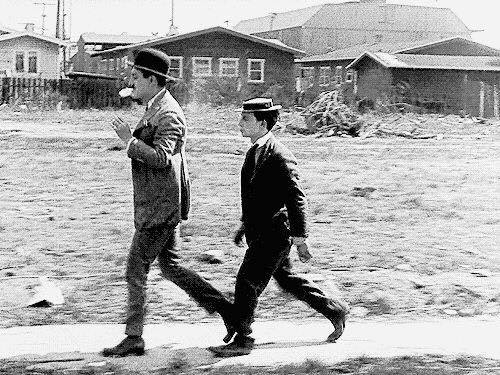Geoff Nicholson's Blog, page 44
July 12, 2017
WALKING IN TIME
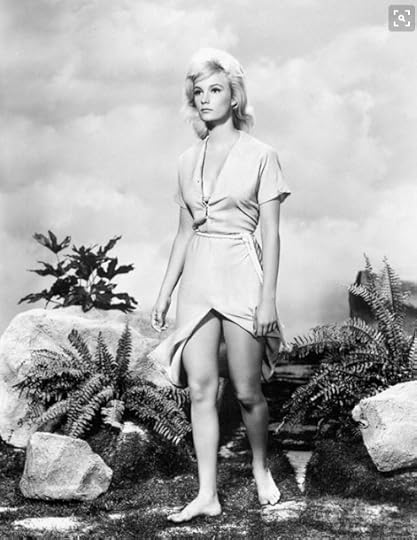 One of the first “grown up” books I ever discovered and read for myself was HG Wells’ The Time Machine. It was in the local library and it had a shiny silver cover, and it was also short.
One of the first “grown up” books I ever discovered and read for myself was HG Wells’ The Time Machine. It was in the local library and it had a shiny silver cover, and it was also short.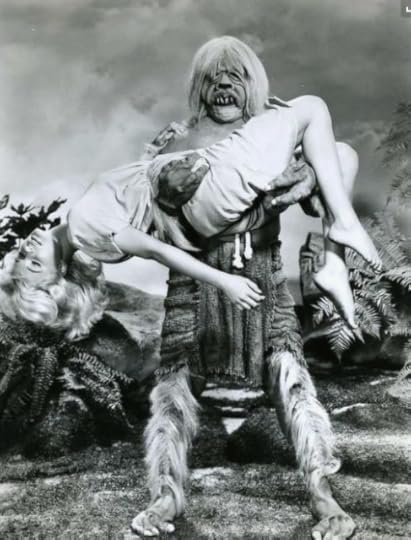
I like to think I still remember it pretty well from that first reading, though I have reread it over the years and of course I’ve seen the George Pal movie. (I preferred the book).
You couldn’t call The Time Machine a book about walking, and yet when the Time Traveller (“for so it will be convenient to speak of him”) makes his second appearance, having been away on his adventures in the fourth dimension, he “walked with just such a limp as I have seen in footsore tramps,” so evidently he’d been doing plenty of walking on his travels.
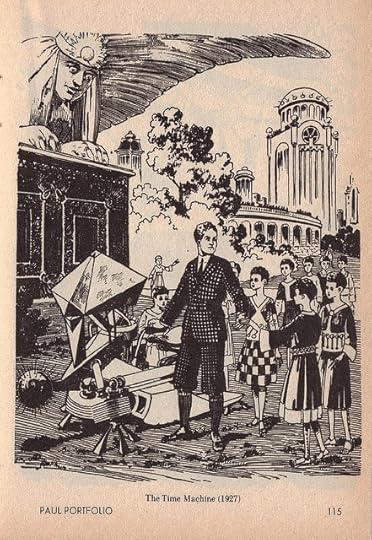 Much of the book is the Time Traveller’s own account of his adventures, and walking is certainly involved, some ruin too; “As I walked I was watching for every impression that could possibly help to explain the condition of ruinous splendour in which I found the world—for ruinous it was. A little way up the hill, for instance, was a great heap of granite, bound together by masses of aluminium, a vast labyrinth of precipitous walls and crumpled heaps ...” Are we in JG Ballard territory yet?
Much of the book is the Time Traveller’s own account of his adventures, and walking is certainly involved, some ruin too; “As I walked I was watching for every impression that could possibly help to explain the condition of ruinous splendour in which I found the world—for ruinous it was. A little way up the hill, for instance, was a great heap of granite, bound together by masses of aluminium, a vast labyrinth of precipitous walls and crumpled heaps ...” Are we in JG Ballard territory yet?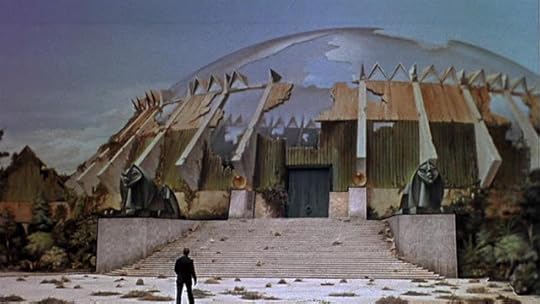
And apparently the people of Wells's future don’t do much walking: “There were no large buildings towards the top of the hill, and as my walking powers were evidently miraculous, I was presently left alone for the first time. With a strange sense of freedom and adventure I pushed on up to the crest.”
The description of the time machine in the book is, I think, deliberately vague, leaving you free to imagine your own apparatus. I always liked this futuristic bicycle version:
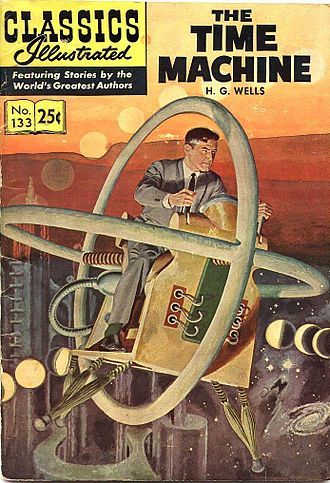
And I found it rather more convincing than the fairground ride kind of thing that’s in the movie, and of course also in the Big Bang Theory:
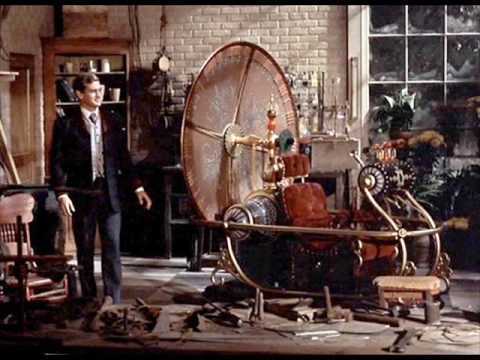
But now that I think about it, I can’t see any reason why a movie remake couldn’t employ a form of walking machine, perhaps “The Time Treadmill,” especially some futuristic one like this:

Gardens do appear here and there in the novel, and at one point the Time Traveller observes that, “There were no hedges, no signs of proprietary rights, no evidences of agriculture; the whole earth had become a garden.”
There’s a JG Ballard short titled the “Garden of Time” featuring Count Axel “a tall, imperious figure in a black velvet jacket, a gold tie-pin glinting below his George V beard, cane held stiffly in a white-gloved hand.” Every evening he and his wife walk in the garden attached to their villa. He looks to the horizon and across the plain where he sees “that the advance columns of an enormous army were moving slowly over the horizon … the army was composed of a vast confused throng of people, men and women, interspersed with a few soldiers in ragged uniforms, pressing forward in a disorganised tide.”
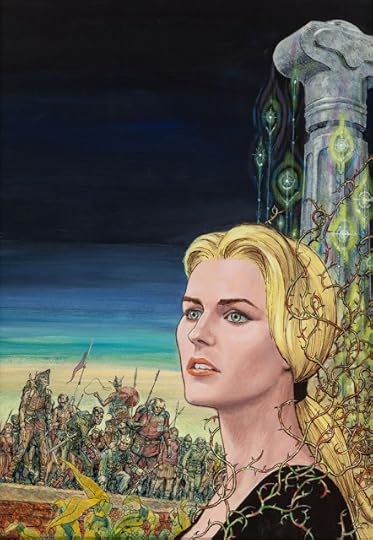
Ed Emshwiller’s illustration for The Garden of Time from The Magazine of Fantasy & Science Fiction, Feb 1962
This rabble is no doubt symbolic, though there are many kinds of symbolism to choose between, but however you slice it, they’re the forces of anarchy and they can only be kept at bay by plucking one of the “time flowers” that grow in the count’s garden. Pick one of those and the rabble retreats, at least for a day. Perhaps they, and the count and his wife, go back in time, but as with most time travel stories, that doesn’t quite work because if time simply reversed then the time flower would still be there unpicked, and the story’s McGuffin is that there are fewer and fewer of the flowers, that chaos and death are coming, at the hands of the riff raff.
This is a picture of JG Ballard doing something (not exactly walking) in his garden.
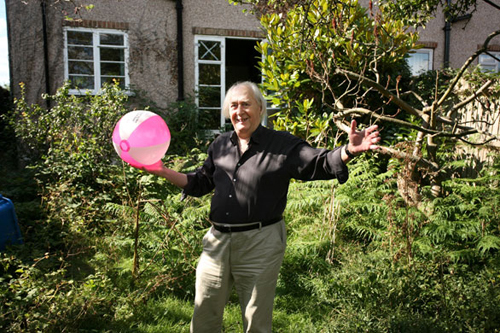
And here’s a picture of HG Wells in a garden, and again not walking, but playing “Little Wars” a game he invented.
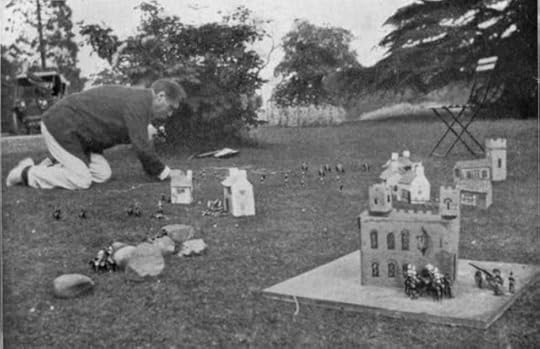

Published on July 12, 2017 10:47
July 10, 2017
EAT MY LOTUS
 NOT Sheffield Park and Gardens.Back in the day I had a girlfriend who, on one occasion, insisted we visit a place in East Sussex called Sheffield Park and Gardens. I went along and I didn’t complain, at least not too much, but at the time I could think of few things more boring or more staid or (god forbid) middle aged than going for a walk in a garden.Well, if we’re lucky enough to survive, middle age has a way or happening to us whether we want it to or not. And these days walking in a garden seems a great pleasure. I accept that it remains bit staid but it’s seldom boring, and I suppose that’s because I’ve trained myself not to be bored.
NOT Sheffield Park and Gardens.Back in the day I had a girlfriend who, on one occasion, insisted we visit a place in East Sussex called Sheffield Park and Gardens. I went along and I didn’t complain, at least not too much, but at the time I could think of few things more boring or more staid or (god forbid) middle aged than going for a walk in a garden.Well, if we’re lucky enough to survive, middle age has a way or happening to us whether we want it to or not. And these days walking in a garden seems a great pleasure. I accept that it remains bit staid but it’s seldom boring, and I suppose that’s because I’ve trained myself not to be bored. I didn’t take any photographs of Sheffield Park at the time, but all the current images show this path and bridge, and I’ve just about convinced myself that I remember them.

More than that, I discover that Sheffield Park and Garden now has a section called Walk Wood, a piece of woodland acquired as a windbreak for the main garden, and at the moment it contains work by a local artist named Keith Pettit who, according to the website, “has created a collection of sculptures that form a new trail through the woodland.”

I’d like to see that, but I happen to find myself living some five and a half thousand miles away. But now that I like gardens, I’ve been able to console myself by visiting at Lotusland, a 37 acre garden up the coast by Santa Barbara. The last owner Ganna Walska (1887-1984) certainly made it what it is today though the overall estate was established in 1882 by Ralph Kinton Stevens who named it "Tanglewood" and turned it unto a lemon and palm and olive nursery. This, I gather, is how it looked in 1896:
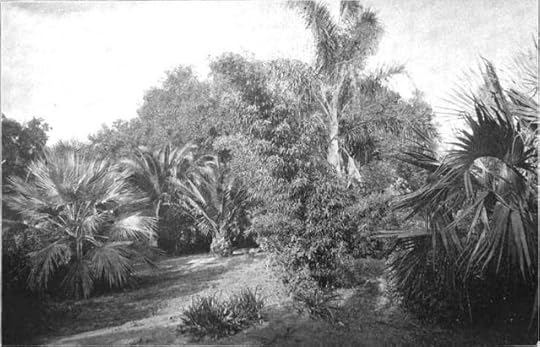
The estate changed hands quite a few times until Madame Walska bought it in 1941 the intention of naming it Tibetland and using it as a retreat for Tibet monks. Her then husband Theos Bernard who was a scholar of Tibetan Buddhism and called himself “the first white lama.”
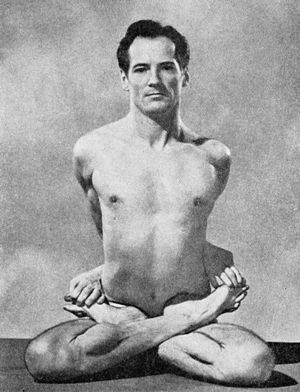
There are still signs of their plans:
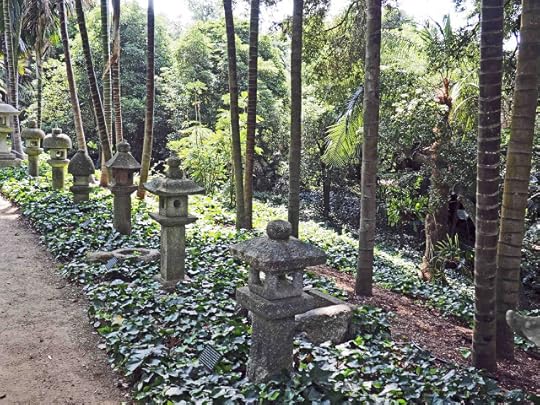
And although there’s nothing resembling a “sculpture trail,” there are these things French “grotesques,” from a previous estate Madame Walska had outside of Paris before the war. When the Nazis came, she fled, and her gardeners who remained buried the grotesques and madam’s Rolls Royce in a hole in the garden, where they remained until the end of hostilities when they were excavated and found to be intact.
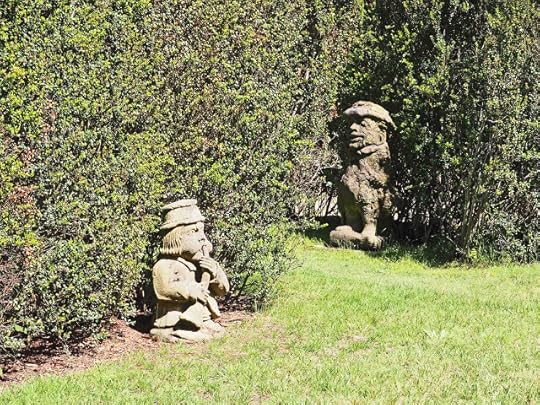
These days Lotusland owned by a trust and is open to the public, but you have to have reservations and unless you’re a member – which is a pricey business – you’re only allowed to walk in the garden as part of guided tour.

Our guide was excellent and the group was small and I knew what I was getting myself into, but even so it was still a bit constraining. In a two hour walk you cover about a mile and a half, so there’s inevitably as much standing about as there is walking, which is not entirely what the psychogeographer ordered.
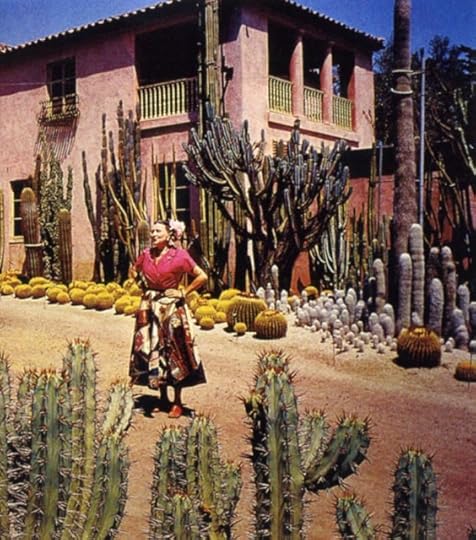
Hard to imagine that Madame Walska was much of a walker, though she did take a daily stroll around her garden, and I imagine came back with a list of improvements to give to the gardener. One also imagines that a walk with Madame Walska would have been a rather theatrical affair.


Published on July 10, 2017 15:46
July 7, 2017
FROM BOWLING GREEN TO THE MARIE ANTOINETTE
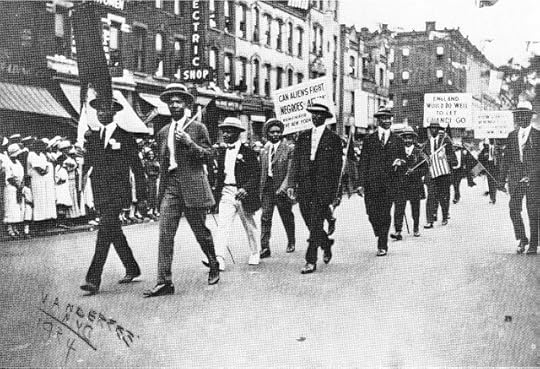
I don’t know much about political and racial infighting in New York in the late 19th and early 20thcenturies, but I do know that the Encyclopedia of African American History describes Charles William Anderson (1866-1938) as “the black Karl Rove of his day” – which sounds hard on anyone - and also as Booker T. Washington’s “eyes and ears and nose and dirty trickster.”
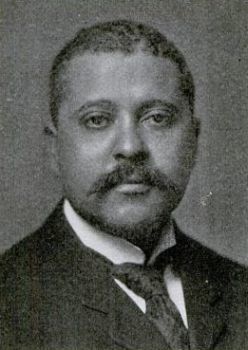
His fortunes rose and fell over the decades but for a very long time he was a man who had to be dealt with in New York politics, and one person who dealt with him was James Weldon Johnson (1871-1938), the author of the social history Black Manhattan, a songwriter, teacher, and a national organizer for the NAACP.
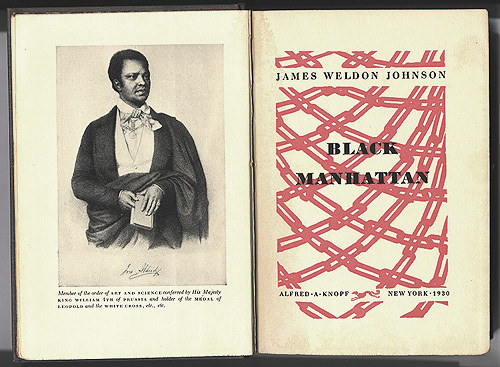

Johnson writes in his autobiography Along This Way,
“I sometimes visited Mr. Anderson at his office in the Custom House to talk over Club matters. (I’m pretty sure this was the ‘Colored Republican Club’) These visits were generally in the afternoon, and he would at times, say, ‘You’re not in a hurry are you? I’ll be through in a little while, and we’ll walk along and talk.’ These walks that seemed like nothing to him taxed me terribly. His antidote for fatigue was to stop in somewhere and get a pint of champagne. I frequently had to rebel against walking another step. I remember that on one afternoon we started from Bowling Green and ended up at the Marie Antoinette Hotel at Broadway and 66th Street. In one of our talks, Mr. Anderson suggested that it would be a nice thing for me to go into the United States Consular Service; he felt sure that President Roosevelt would be willing to appoint me.”
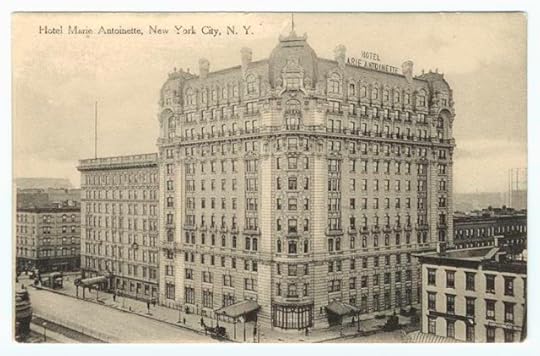
The walk from Bowling Green to the Marie Antoinette would have been a little over five miles (the hotel is long gone), so not an especially heroic walk, but a long way if you’re not ready for it, I suppose. And I do wonder how many places there were in Manhattan at that time where a black politician could order a pint of champagne. Perhaps quite a few. But Anderson was right: Johnson was duly appointed a US Consul, first to Venezuela and then to Nicaragua, between 1906 and 1912: interesting times.
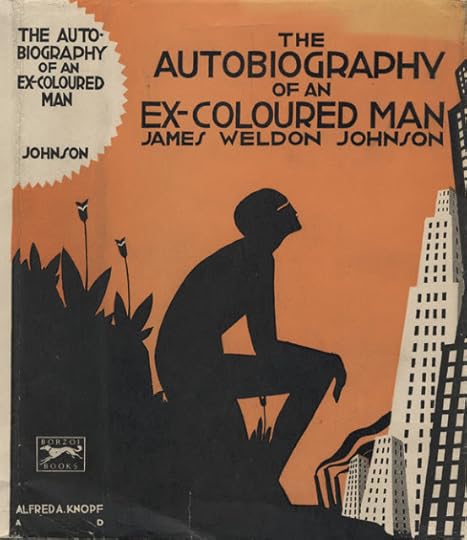
Despite his “rebelling” against Anderson's enforced walk, Johnson knew at least something about the pleasures of walking. Here’s a passage about New York from his novel The Autobiography of an Ex-Colored Man (1912)“As I walked about that evening I began to feel the dread power of the city; the crowds, the lights, the excitement, the gayety and all its subtler stimulating influences began to take effect upon me. My blood ran quicker, and I felt that I was just beginning to live. To some natures this stimulant of life in a great city becomes a thing as binding and necessary as opium is to one addicted to the habit. It becomes their breath of life; they cannot exist outside of it; rather than be deprived of it they are content to suffer hunger, want, pain and misery; they would not exchange even a ragged and wretched condition among the great crowd for any degree of comfort away from it.”

Published on July 07, 2017 09:10
June 29, 2017
GOOD FENCES, SO-SO NEIGHBORS

When I first moved to Los Angeles there was a book in all the bookstores titled The Secret Gardens of Hollywood by Adele Cygelman, and I looked at it and did think of buying it because I like gardens and I like secrets, but it was $45 and so in the end I didn’t, but that title stayed on my mind.
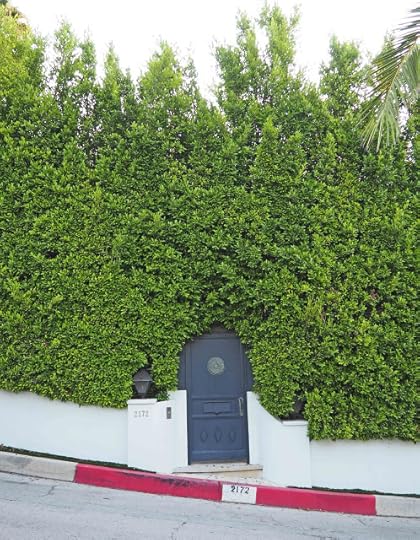
Then, as I walked and explored the city, I soon learned that a very high percentage of gardens in these parts are in fact “secret” gardens, at least to the extent that they have high walls and tall hedges, fiercely impenetrable gates, and they turn their backs on the world, creating a private space that can’t be seen by the passing polloi: that would be me.
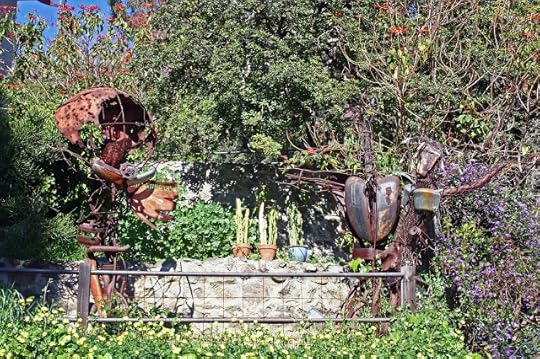
This applies more to the hills than to the flatlands, and more to the rich than the poor, and there are exceptions in all directions, but the general principle remains sound, I think. There’s even a thing that the local garden nurseries call a Hollywood hedge – like this:

And here's one in my own neighborhood:
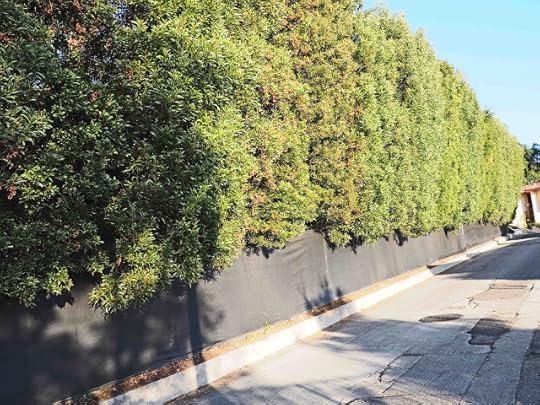
But another thing, and in a sense it’s the same thing, a great many properties have a thin sliver of land that’s outside the fence or hedge, and the proud home owner doesn’t think much about it, certainly doesn’t think of it as part of the garden, and so it gets ignored and neglected, and “nature” takes over.
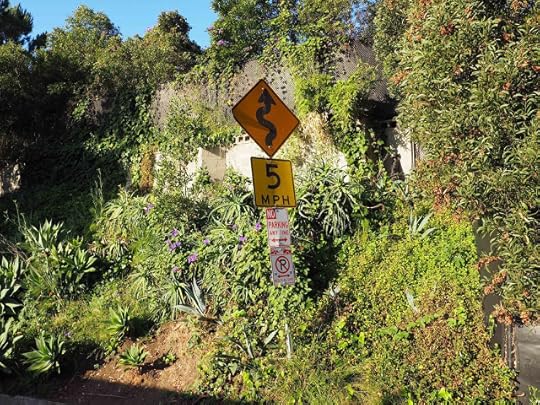
On the other side of the gate or wall or hedge, there’s order, and outside there’s chaos. Both obviously have their place and their attractions, but as a walker you see far more chaos than you do order. You can pick the symbolism out of that one till the cows come home.
Mr Brad Pitt lives on the other side of this mess:
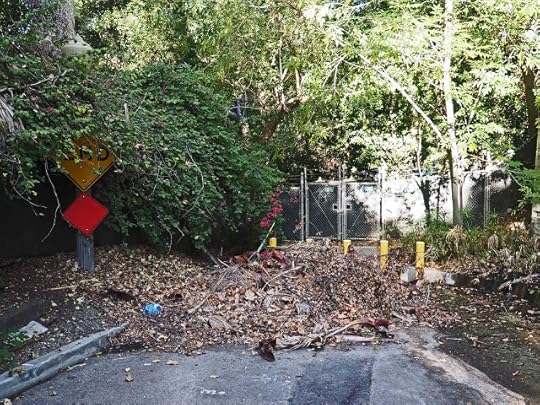

Published on June 29, 2017 18:12
June 28, 2017
GOOD FENCES, SO-SO NEIGHBORS
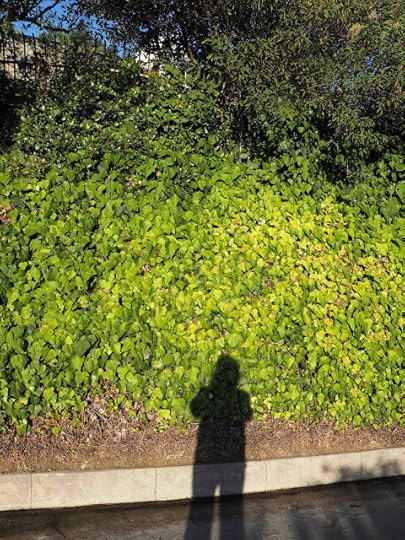
When I first moved to Los Angeles there was a book in all the bookstores titled The Secret Gardens of Hollywood by Adele Cygelman, and I looked at it and did think of buying it because I like gardens and I like secrets, but it was $45 and so in the end I didn’t, but that title stayed on my mind.

Then, as I walked and explored the city, I soon learned that a very high percentage of gardens in these parts are in fact “secret” gardens, at least to the extent that they have high walls and tall hedges, fiercely impenetrable gates, and they turn their backs on the world, creating a private space that can’t be seen by the passing polloi: that would be me.

This applies more to the hills than to the flatlands, and more to the rich than the poor, and there are exceptions in all directions, but the general principle remains sound, I think. There’s even a thing that the local garden nurseries call a Hollywood hedge – like this:

And here's one in my own neighborhood:

But another thing, and in a sense it’s the same thing, a great many properties have a thin sliver of land that’s outside the fence or hedge, and the proud home owner doesn’t think much about it, certainly doesn’t think of it as part of the garden, and so it gets ignored and neglected, and “nature” takes over.

On the other side of the gate or wall or hedge, there’s order, and outside there’s chaos. Both obviously have their place and their attractions, but as a walker you see far more chaos than you do order. You can pick the symbolism out of that one till the cows come home.
Mr Brad Pitt lives on the other side of this mess:


Published on June 28, 2017 16:32
June 22, 2017
FITTEST?
My friend Tammy sent me an article from the BBC titled “What you can learn from Einstein’s quirky habits,” subtitled “More than 10 hours of sleep and no socks – could this be the secret to thinking like a genius?” - To which Betteridge’s law of headlines (and I suppose subtitles) surely applies: Any headline that ends in a question mark can be answered by the word no. It was one of those “geniuses do the darnedest things” type article, but it was sent to me because of old man Einstein’s walking habits. This is him in Princeton:

The article ran, “Einstein’s daily walk was sacred to him. While he was working at Princeton University, New Jersey, he’d walk the mile and a half journey there and back. He followed in the footsteps of other diligent walkers, including Darwin who went for three 45 minute walks every day.”
I must say I first read that as Darwin doing forty-five walks of 3 minutes each which would have been really off the wall, but he wasn’t quite that eccentric. In fact three walks a day doesn’t strike me as all eccentric at all.
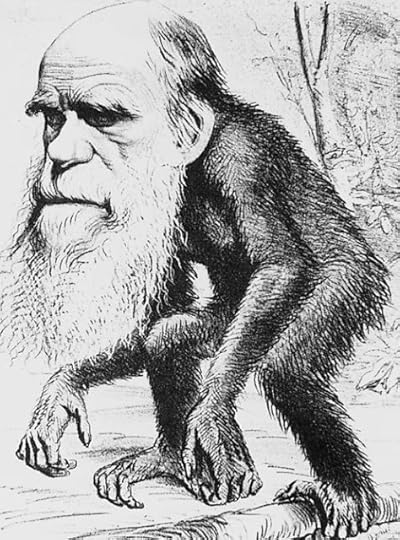
Darwin’s son Francis drew up a timetable describing his father’s typical day in middle age and later. One walk before breakfast, one before lunch “starting with visit to greenhouse, then round the sandwalk, the number of times depending on his health, usually alone or with a dog,” then another at 4 pm “usually round sandwalk, sometimes farther afield and sometimes in company.” There was also a fair amount of work, rest, and having his wife Emma read to him.
So yes 3 walks of 45 minutes, more or less, sometimes shorter, sometimes longer. The “sandwalk” also referred to as Darwin “think path” was, and is, a gravel track around Sandwalk Wood a piece of land Darwin rented then owned, adjacent to his house. Darwin walked circuits on the path. Today it looks like this:

The sandwalk is only a quarter of a mile in circumference, so you could get around it quite a few times in 45 minutes, and it’s said that Darwin set up a pile of stones at a certain point on the circuit so that he could kick away one of them each time he passed, so he wouldn’t have to interrupt his thinking by counting the number of circuits he’d done, although you may also ask why he needed to count circuits at all.

I’d have thought somebody would have taken a photograph of Darwin walking but if they did I can’t find one, though there is this fine one of him on a horse:

As for Einstein, the BBC article continues, “No list of Einstein’s eccentricities would be complete without a mention of his passionate aversion to socks. ‘When I was young,’ he wrote in a letter to his cousin – and later, wife – Elsa, ‘I found out that the big toe always ends up making a hole in a sock. So I stopped wearing socks.’”
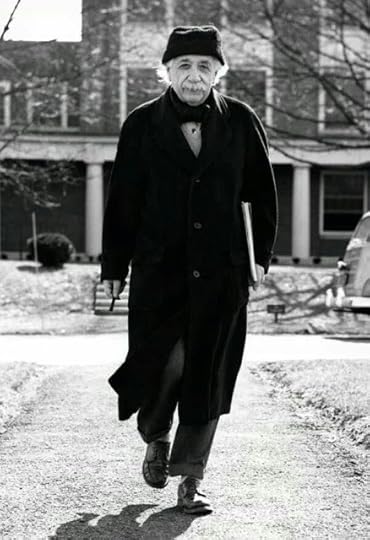
Now you and I may have thought that shoes without socks was just an annoying hipster affectation, and definitely no good for walking, but wait, there’s more in the article, “Later in life, when he couldn’t find his sandals he’d wear Elsa’s sling backs instead.” Now this is way more than eccentric, if you ask me.

As you see in the picture above he is indeed wearing what appear to be women’s shoes, although not sling backs, and whether they’re his wife’s or his own or somebody else’s I can’t say. And at other times …
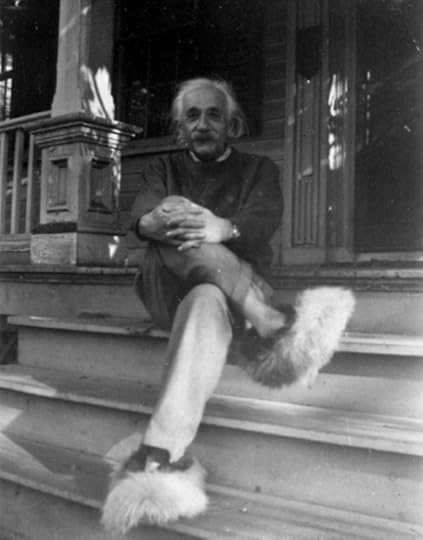


The article ran, “Einstein’s daily walk was sacred to him. While he was working at Princeton University, New Jersey, he’d walk the mile and a half journey there and back. He followed in the footsteps of other diligent walkers, including Darwin who went for three 45 minute walks every day.”
I must say I first read that as Darwin doing forty-five walks of 3 minutes each which would have been really off the wall, but he wasn’t quite that eccentric. In fact three walks a day doesn’t strike me as all eccentric at all.

Darwin’s son Francis drew up a timetable describing his father’s typical day in middle age and later. One walk before breakfast, one before lunch “starting with visit to greenhouse, then round the sandwalk, the number of times depending on his health, usually alone or with a dog,” then another at 4 pm “usually round sandwalk, sometimes farther afield and sometimes in company.” There was also a fair amount of work, rest, and having his wife Emma read to him.
So yes 3 walks of 45 minutes, more or less, sometimes shorter, sometimes longer. The “sandwalk” also referred to as Darwin “think path” was, and is, a gravel track around Sandwalk Wood a piece of land Darwin rented then owned, adjacent to his house. Darwin walked circuits on the path. Today it looks like this:

The sandwalk is only a quarter of a mile in circumference, so you could get around it quite a few times in 45 minutes, and it’s said that Darwin set up a pile of stones at a certain point on the circuit so that he could kick away one of them each time he passed, so he wouldn’t have to interrupt his thinking by counting the number of circuits he’d done, although you may also ask why he needed to count circuits at all.

I’d have thought somebody would have taken a photograph of Darwin walking but if they did I can’t find one, though there is this fine one of him on a horse:

As for Einstein, the BBC article continues, “No list of Einstein’s eccentricities would be complete without a mention of his passionate aversion to socks. ‘When I was young,’ he wrote in a letter to his cousin – and later, wife – Elsa, ‘I found out that the big toe always ends up making a hole in a sock. So I stopped wearing socks.’”

Now you and I may have thought that shoes without socks was just an annoying hipster affectation, and definitely no good for walking, but wait, there’s more in the article, “Later in life, when he couldn’t find his sandals he’d wear Elsa’s sling backs instead.” Now this is way more than eccentric, if you ask me.

As you see in the picture above he is indeed wearing what appear to be women’s shoes, although not sling backs, and whether they’re his wife’s or his own or somebody else’s I can’t say. And at other times …


Published on June 22, 2017 12:07
June 19, 2017
WALKING ON SUNSHINE ON SHEFFIELD

There’s a commercial currently running on American TV for the Ford Edge – a vehicle about which I have no opinion for or against. The narrative of the ad has a guy missing his wife, who appears to be away on a business trip, so he gets in his car and drives a long way, possibly a thousand miles, to surprise his wife in her hotel room.
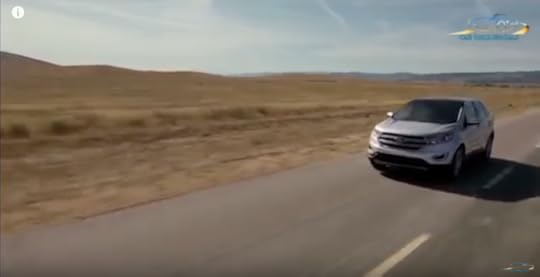
Anyway, a banal enough story. Things are improved somewhat by the music – the Proclaimers’ “I’m Gonna Be (500 Miles)” a good song to be sure, but did nobody at Ford or their ad agency ever listen to the effin lyrics?
But I would walk 500 milesAnd I would walk 500 moreTo be the man who walked a thousand milesTo fall down at your door
It’s about walking, you clowns! Not about driving an effin Ford Edge or anything else!Hold that thought.
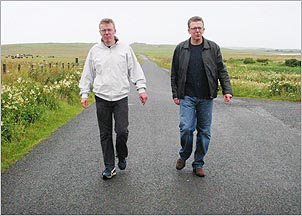
A few years back me and my Yorkshire psychogeographic pal Steve went from his house in Sheffield to Saltaire (in a Skoda rather than a Ford) to see the David Hockney gallery there, in Salt Mill.
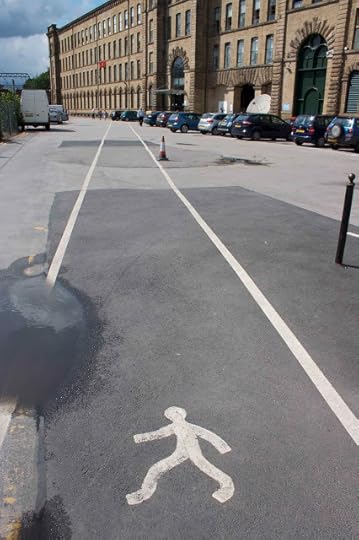
And afterwards we wandered the streets of the town and went down by the river and into the park, and as we were walking Steve came down with something very unpleasant, a stomach thing, I think. But he was very stoic, and then we drove home to Steve’s house – more like 50 miles than 1000.
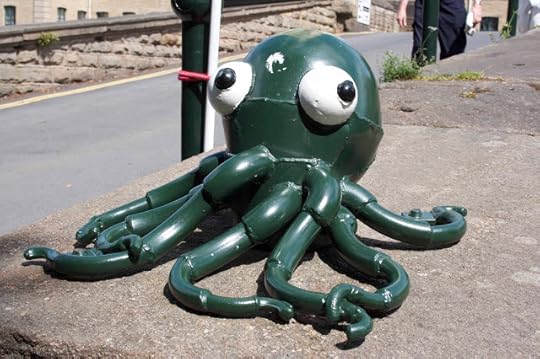

And when we got home, Steve’s stoicism slipped and he submitted to whatever was ailing him. Meanwhile, it just so happened that the Proclaimers were playing in the Sheffield Botanic Gardens – a place I used to walk many a lunchtime when they let us out of the big bad grammar school I went to.
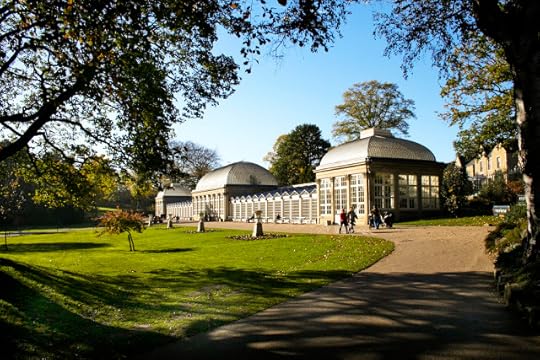
There was a bit of a sunset that night in Sheffield and from Steve’s backyard you could watch the sky and listen to the music drifting across the hills, and soon enough it came
But I would walk 500 milesAnd I would walk 500 more
By which time Steve looked as though he’d struggle to walk from one side of the yard to the other.


Published on June 19, 2017 12:25
June 12, 2017
SIGNS OF WALKING
We Hollywood walker types are intrigued by street signs involving pedestrians, and I happened to be reading an article in the New York Times by Mokoto Rich about the “Daunting economic woes” of South Korea. And one of the photographs illustrating the article showed university students in Seoul “where job prospects are a concern.” This one

And I saw, rather small, in the picture there was a yellow triangular sign, too small to make out very clearly but it definitely showed a walking man and a car, and there was some kind of curvy symbol between them, apparently emerging from the car. I thought it looked like the car was farting on the man – or I supposed, more realistically, showering him with exhaust fumes. But I showed it to my companion and she reckoned it looked as though the car was shouting at him.

We were both wrong, as you see above: the “curvy symbol” indicated a collision between man and machine, and what we hadn’t noticed in the picture because it was too small, was that the pedestrian was staring at his cell phone. The sign is simply telling pedestrians not to get so engrossed in their phones that they bump into cars. A message we can all get behind surely. Though of course, if you were totally engrossed in your phone you wouldn’t have seen the sign,even if it were on the ground, as below, but this is the paradox with which distracted pedestrians, and drivers, have to live.
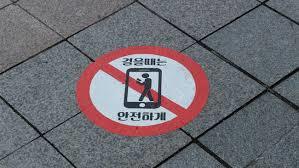
Denounce me as a libertarian if you like, but it seems to me that people should take responsibility for their own lives, and if they’re really too stupid not to have worked out that walking while messing with a phone is dangerous, then I suspect no amount of signage is likely to help.
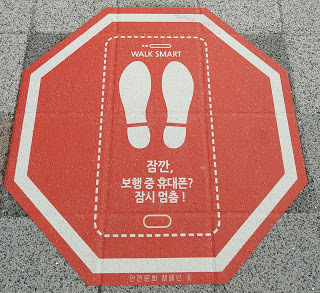
The Koreans also have the sign above: I think the idea is that you place your feet on the footprints and stand there playing with your phone – much to the annoyance of passersby as they swarm around you, I assume.
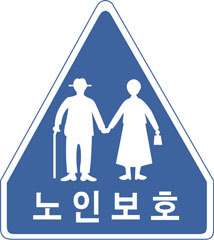
And there is the one above that strikes me as vaguely insulting: two old geezers holding hands. I imagine it’s supposed to be sweet but it strikes me as condescending (and ageist) because it’s not warning old people about cars, it’s warning car drivers about old people, with their walking sticks and their handbags, as though they’re too feeble to look out for themselves. There are a great many old people to whom this does not apply.

Which brings me to the life and death of Seuk Doo Kim (above), a 78 year old hiker, of Korean origin, who planned to climb Mount Baldy 1000 times. Now Mount Baldy has always struck me as sheer hell; a 10,000 foot peak in California’s San Gabriel Range, a punishing ascent to be sure, but whenever I’ve seen pictures it’s always looked overpopulated. Still, to each his own. And in fact he walked plenty of other places too.

Seuk Doo Kim, known as Sam, didn’t make it to 1000 ascents. He’d done about 800 when he fell to his death from a trail on the northwest side of the mountain. By all accounts Sam was ‘irrepressible,” talking exuberantly to anybody he met, helping lost hikers, handing out food, posing for selfies. The LA Times quoted him as saying, “My shortcut is the Holy Spirit.” I don’t suppose the Koreans, or anybody else, have a sign for that.
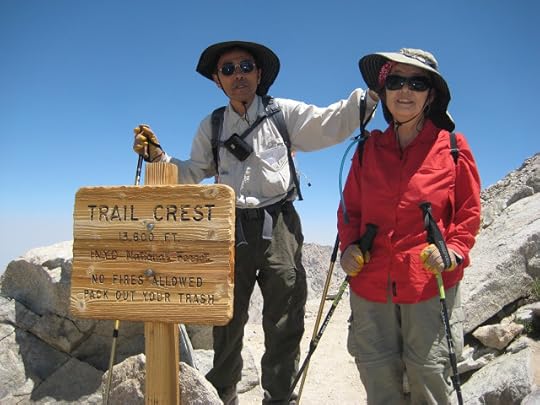


And I saw, rather small, in the picture there was a yellow triangular sign, too small to make out very clearly but it definitely showed a walking man and a car, and there was some kind of curvy symbol between them, apparently emerging from the car. I thought it looked like the car was farting on the man – or I supposed, more realistically, showering him with exhaust fumes. But I showed it to my companion and she reckoned it looked as though the car was shouting at him.

We were both wrong, as you see above: the “curvy symbol” indicated a collision between man and machine, and what we hadn’t noticed in the picture because it was too small, was that the pedestrian was staring at his cell phone. The sign is simply telling pedestrians not to get so engrossed in their phones that they bump into cars. A message we can all get behind surely. Though of course, if you were totally engrossed in your phone you wouldn’t have seen the sign,even if it were on the ground, as below, but this is the paradox with which distracted pedestrians, and drivers, have to live.

Denounce me as a libertarian if you like, but it seems to me that people should take responsibility for their own lives, and if they’re really too stupid not to have worked out that walking while messing with a phone is dangerous, then I suspect no amount of signage is likely to help.

The Koreans also have the sign above: I think the idea is that you place your feet on the footprints and stand there playing with your phone – much to the annoyance of passersby as they swarm around you, I assume.

And there is the one above that strikes me as vaguely insulting: two old geezers holding hands. I imagine it’s supposed to be sweet but it strikes me as condescending (and ageist) because it’s not warning old people about cars, it’s warning car drivers about old people, with their walking sticks and their handbags, as though they’re too feeble to look out for themselves. There are a great many old people to whom this does not apply.

Which brings me to the life and death of Seuk Doo Kim (above), a 78 year old hiker, of Korean origin, who planned to climb Mount Baldy 1000 times. Now Mount Baldy has always struck me as sheer hell; a 10,000 foot peak in California’s San Gabriel Range, a punishing ascent to be sure, but whenever I’ve seen pictures it’s always looked overpopulated. Still, to each his own. And in fact he walked plenty of other places too.

Seuk Doo Kim, known as Sam, didn’t make it to 1000 ascents. He’d done about 800 when he fell to his death from a trail on the northwest side of the mountain. By all accounts Sam was ‘irrepressible,” talking exuberantly to anybody he met, helping lost hikers, handing out food, posing for selfies. The LA Times quoted him as saying, “My shortcut is the Holy Spirit.” I don’t suppose the Koreans, or anybody else, have a sign for that.


Published on June 12, 2017 18:17
June 9, 2017
SOME NEW THOMASSONS
Well, new to me anyway, and seen while out walking, though I suppose, by definition, a Thomasson is never brandnew, since it’s always a relic or an abandoned and repurposed architectural feature that can subsequently be perceived, however ironically, as a piece of art. That’s my own definition by the way: there may well be better ones out there.
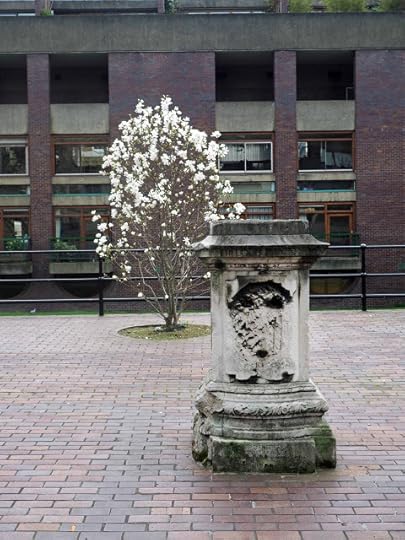
Let’s start with a couple of empty pedestals or plinths – the one above is in the shadow of the Barbican Center in London, which is to say it’s also very close to the old city wall. I’m intrigued by the dense black coating up at the top of the molding. Is that industrial pollution? Did the whole thing used to be that color? It doesn’t look like anybody cleaned it – they’d surely have done a better job - so has the grime just fallen away? These are not entirely rhetorical questions. And presumably it once had a statue on top of it, I wonder of who or what.
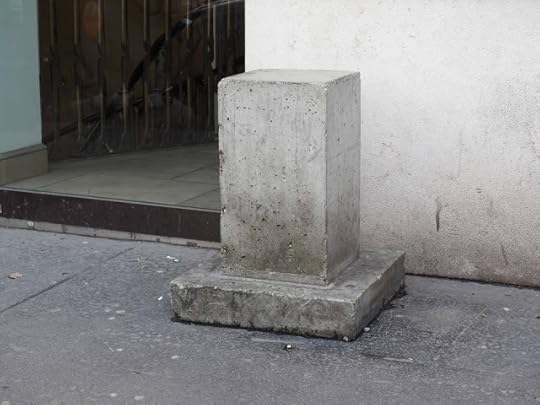
The one above, less ornate, chunkier, cleaner, is to be found just outside the Inner Ring in Vienna, a city where the most incredible bits of statuary are everywhere, but this pedestal would be completely overwhelmed by any of the “typical” Viennese statues you see. And looking at that rather smooth top, I tend to think it maybe never had anything on it at all, and it’s probably just waiting for some artist to use it and give it life.
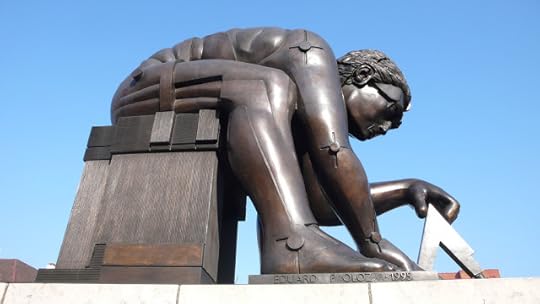
An artist like Eduardo Paolozzi perhaps, dead now, so not him specifically, though he’d definitely have done a good job. But I was thinking of him because not so long ago I went to an exhibition of his work at the Whitechapel Gallery in London and I looked out of one of the windows adjacent to the staircase and saw this:
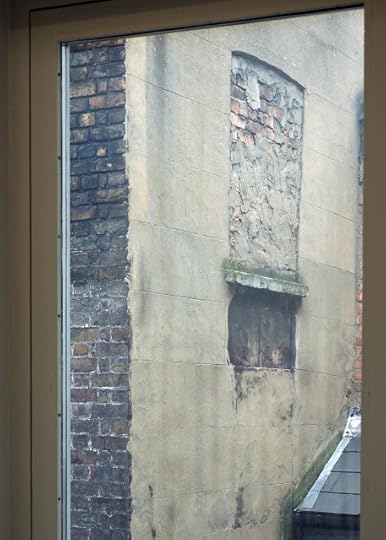
I guess if you saw it elsewhere you might think of it as just another bricked up window, but the combination of Paolozzi, the Thomason mindset, and the presence of art at the Whitechapel makes you, or at any rate me, see things a bit differently.
Meanwhile in my own neighborhood in Hollywood I saw this:
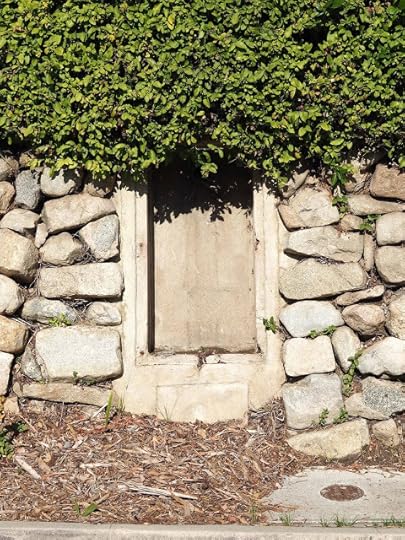
Kind of looks like a niche, the kind of thing you might put a statue of the Virgin Mary in. (As Dorothy Parker may or may not have said: “Upon my honor/ I saw a Madonna//Standing in a niche …”The rest is just abuse and you can look it up for yourself if you need to). But a closer inspection of the niche reveals some electrical wires up at the top, and a broader view shows a shiny new electricity meter off to the left, so I’m guessing the niche was formerly the home of an old meter.
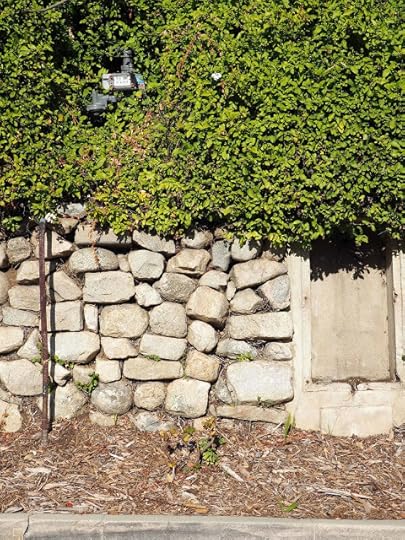
But I do think I'd put some kind of statuary in there if it were mine.
And finally in my own own street, this thing;

Eyes without a face I suppose, although there is kind of a face, or am I just indulging in pareidolia? In any case I can’t imagine what this was ever part of but I’m very glad it’s still there.


Let’s start with a couple of empty pedestals or plinths – the one above is in the shadow of the Barbican Center in London, which is to say it’s also very close to the old city wall. I’m intrigued by the dense black coating up at the top of the molding. Is that industrial pollution? Did the whole thing used to be that color? It doesn’t look like anybody cleaned it – they’d surely have done a better job - so has the grime just fallen away? These are not entirely rhetorical questions. And presumably it once had a statue on top of it, I wonder of who or what.

The one above, less ornate, chunkier, cleaner, is to be found just outside the Inner Ring in Vienna, a city where the most incredible bits of statuary are everywhere, but this pedestal would be completely overwhelmed by any of the “typical” Viennese statues you see. And looking at that rather smooth top, I tend to think it maybe never had anything on it at all, and it’s probably just waiting for some artist to use it and give it life.

An artist like Eduardo Paolozzi perhaps, dead now, so not him specifically, though he’d definitely have done a good job. But I was thinking of him because not so long ago I went to an exhibition of his work at the Whitechapel Gallery in London and I looked out of one of the windows adjacent to the staircase and saw this:

I guess if you saw it elsewhere you might think of it as just another bricked up window, but the combination of Paolozzi, the Thomason mindset, and the presence of art at the Whitechapel makes you, or at any rate me, see things a bit differently.
Meanwhile in my own neighborhood in Hollywood I saw this:

Kind of looks like a niche, the kind of thing you might put a statue of the Virgin Mary in. (As Dorothy Parker may or may not have said: “Upon my honor/ I saw a Madonna//Standing in a niche …”The rest is just abuse and you can look it up for yourself if you need to). But a closer inspection of the niche reveals some electrical wires up at the top, and a broader view shows a shiny new electricity meter off to the left, so I’m guessing the niche was formerly the home of an old meter.

But I do think I'd put some kind of statuary in there if it were mine.
And finally in my own own street, this thing;

Eyes without a face I suppose, although there is kind of a face, or am I just indulging in pareidolia? In any case I can’t imagine what this was ever part of but I’m very glad it’s still there.

Published on June 09, 2017 11:05
June 4, 2017
BUSTER
Published on June 04, 2017 09:03
Geoff Nicholson's Blog
- Geoff Nicholson's profile
- 55 followers
Geoff Nicholson isn't a Goodreads Author
(yet),
but they
do have a blog,
so here are some recent posts imported from
their feed.


